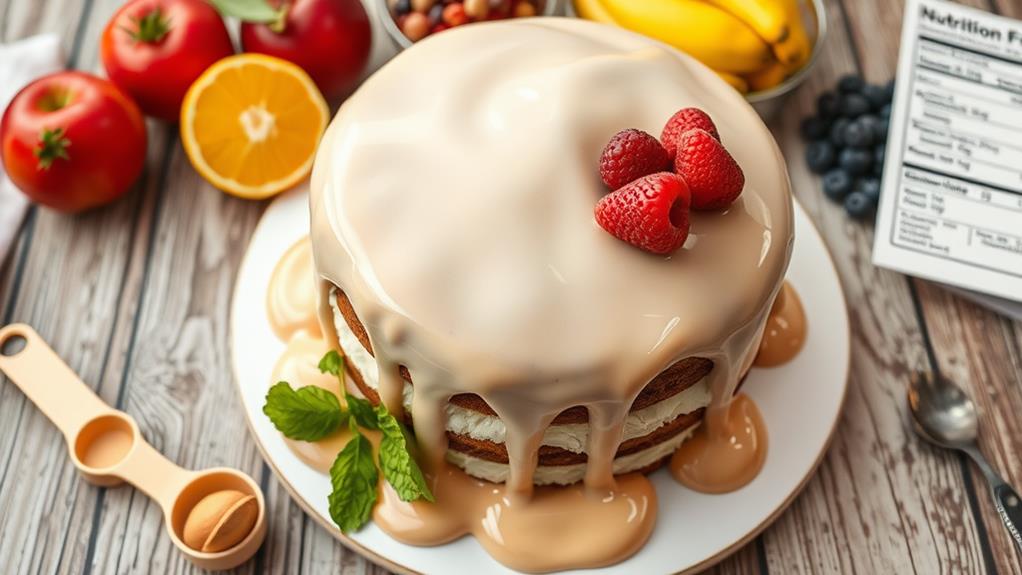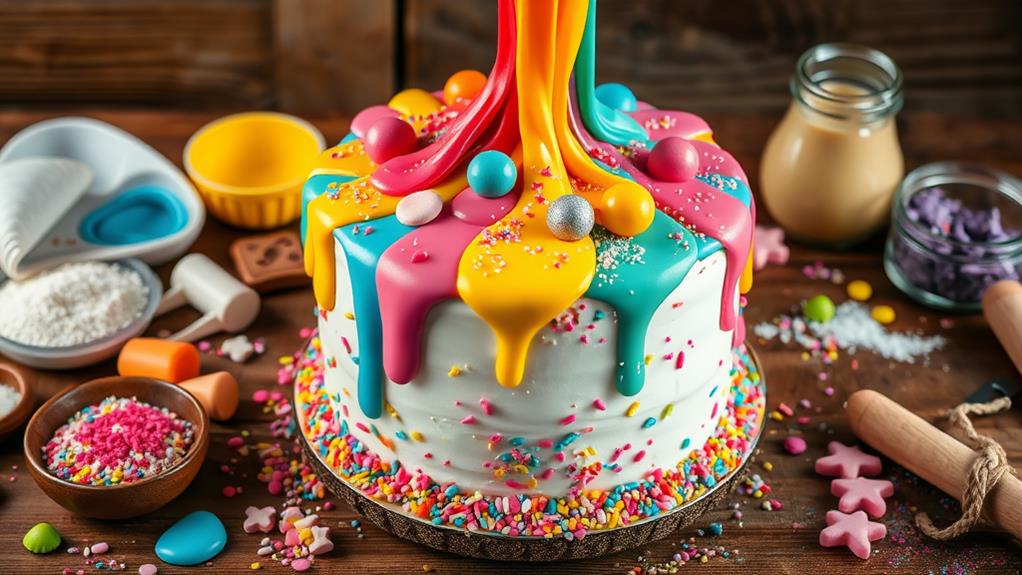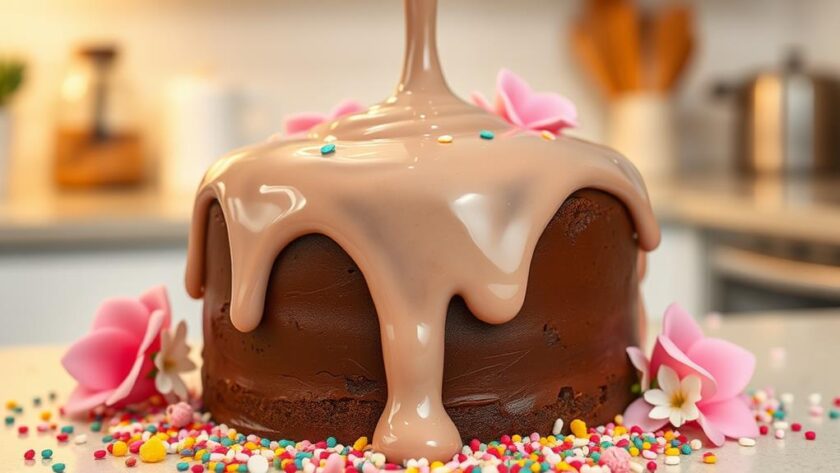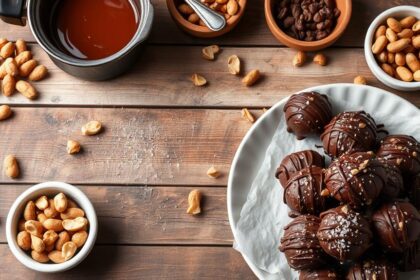Pourable fondant is a quick and easy icing that gives your cakes a glossy, professional finish. To make it, combine 1/4 cup very hot water, 1/4 cup light corn syrup, and 1 tsp vanilla extract in a saucepan. Gradually whisk in 4 cups sifted powdered sugar until smooth. Cool to about 100°F before pouring it over your lightly iced cake for even coverage. Want to customize it? You can add food coloring or flavored extracts for a personal touch. Curious about storage tips or alternate ingredients? There's plenty more to explore to perfect your cake decorating skills!
What Is Pourable Fondant?
Pourable fondant is a glossy icing that gives your cakes, pastries, and petits fours a smooth, shiny finish. Unlike rolled fondant, which you might find too thick or dough-like, pourable fondant is a glaze made primarily from powdered sugar. This makes it lighter and more fluid, perfect for drizzling over your baked goods.
To achieve the best results, you should pour your fondant at around 100°F. This temperature keeps the icing pourable, allowing it to coat your treats evenly without being so hot that it damages the cake. One of the fantastic aspects of pourable fondant is that you can tint it with food coloring, giving you the freedom to customize the look for any occasion.
Incorporating a smooth ganache can enhance the overall flavor and texture experience, similar to the rich layers found in an Opera dessert.
Once applied, pourable fondant hardens quickly, forming a sealed layer that helps retain moisture in the cake below. This not only enhances the texture but also adds to the overall presentation.
Key Ingredients for Fondant
When making pourable fondant, you'll need a few key ingredients to get that perfect consistency and flavor.
You can enhance the nutritional value of your treats by considering healthier sweeteners and sugar substitutes to replace traditional options, providing added vitamins and minerals.
Additionally, feel free to play around with alternative sweeteners and enhance the taste with your favorite extracts.
Let's explore these essential components to elevate your fondant experience.
Essential Ingredients Overview
Creating a smooth and delicious poured fondant starts with understanding its essential ingredients. The primary component of your poured fondant recipe is confectioners' sugar, which provides the sweetness and structure needed for that perfect icing.
You'll also want to include light corn syrup, as it adds moisture and smoothness while helping to prevent crystallization.
Water is vital for dissolving the sugar and creating your base mixture. Using very hot water is often recommended to guarantee ideal melting and consistency.
A splash of vanilla extract is key too—it enhances the flavor profile, making your fondant not only visually appealing but also delicious when coating cakes and pastries.
Don't forget a pinch of salt! This small addition balances the sweetness and elevates the overall taste of your poured fondant.
By understanding these essential ingredients, you're setting yourself up for success in achieving a fondant that's both beautiful and tasty.
With the right mix of these basics, you'll be ready to decorate your cakes with confidence!
Alternative Sweeteners Options
There are several alternative sweeteners you can use in your poured fondant recipe that can enhance flavor and texture. One excellent substitute is liquid glucose, which works similarly to light corn syrup, providing the same level of sweetness and moisture retention. This can help achieve that perfect, smooth consistency you're aiming for.
Another option is Lyles Golden Syrup, which replaces corn syrup and adds a subtle flavor while maintaining the fondant's desired texture. If you're looking for a more natural choice, rice syrup can also serve as a corn syrup substitute, though keep in mind it may slightly alter the color of your fondant due to its natural hue.
You might also want to contemplate adding glycerin to your poured fondant. This ingredient not only enhances the shine but also improves the overall finish of your icing, giving it that professional touch.
Just be cautious when using amber-colored syrups, as they can tint your fondant, impacting its visual appeal. With these alternatives, you can customize your fondant to suit your taste while still achieving a beautiful cake decoration.
Flavoring Enhancements Suggestions
Flavoring your poured fondant can elevate its taste and make your cake truly memorable. Start by incorporating flavor extracts like almond or lemon to enhance the fondant's taste profile, customizing it to match your cake's flavor. For a classic touch, use clear vanilla extract instead of brown vanilla. This way, you'll maintain the pure whiteness of your fondant, avoiding any unwanted tint.
Another great addition is glycerin. A small amount not only gives your fondant a beautiful shine but also contributes subtle flavor notes, guaranteeing a smoother finish.
If you want to get a bit creative, think about mixing in flavored syrups or jams, such as raspberry or orange. This adds a distinct flavor while introducing a hint of color, making your fondant even more appealing.
Just remember to keep any added flavorings or colorings below the ideal pouring temperature of 100°F. This prevents graininess and guarantees a smooth consistency.
Step-by-Step Preparation

To make pourable fondant, start by combining 1/4 cup of very hot water, 1/4 cup of light corn syrup, and 1 teaspoon of vanilla extract in a saucepan. This mixture serves as a smooth base that can enhance your cake's overall presentation, especially when paired with creative plating techniques like playing with textures and colors.
Stir these ingredients together to create a smooth base for your poured fondant. Gradually whisk in 4 cups of sifted powdered sugar, mixing until the consistency is smooth and coats the back of a spoon.
Once combined, allow the mixture to cool to approximately 100°F. If you want to add color, now's the time! Mix in your food coloring to achieve the desired shade without compromising the texture.
For the best results, pour the fondant over lightly iced cakes or petits fours. This helps the fondant flow evenly, covering every surface. If you notice any bare spots, use a spatula to touch them up.
Storage Tips for Fondant
Properly storing your pourable fondant can greatly extend its shelf life and maintain its quality. When you want to store fondant, keep it covered properly with plastic wrap. Adding a few water droplets on the surface helps prevent crusting, allowing you to store it at room temperature for 2-3 days.
For a healthier twist on your cake decorations, consider using healthier ingredient swaps that can enhance flavor and nutrition.
If you need a longer shelf life, refrigeration is your best option. This method can keep your poured fondant fresh for up to a week without compromising its quality. For even more extended storage, you can freeze the fondant for up to three months. Just remember to drain any excess water before you reuse it.
Always use an airtight container when you store fondant. This keeps moisture in and guarantees the consistency remains perfect until you're ready to use it.
When the time comes to revive your stored fondant, gently reheat it in the microwave or on the stovetop. Stir until it reaches a smooth, pourable consistency, and you'll be all set to decorate your cakes!
Nutritional Information

When it comes to poured fondant, understanding its nutritional information can help you make informed choices for your baking projects. Much like the classic chocolate chip cookies, poured fondant can elevate your desserts, making them visually appealing while also being sweet.
A serving of poured fondant icing contains approximately 68 calories, which primarily come from its high sugar content. This means it's a sweet treat that can quickly boost your energy levels.
Each serving provides around 18 grams of carbohydrates, making it a considerable source of quick energy. If you're mindful of fat content, you'll be pleased to know that poured fondant is nearly fat-free, containing just 0.005 grams per serving. This makes it an excellent low-fat icing option for your cakes.
Poured fondant also has a sodium content of 10 mg per serving, which contributes to its overall flavor without greatly impacting your dietary sodium limits. However, it offers minimal nutritional value beyond its role as a sweet decorative topping, with only 0.4 mg of potassium per serving.
User Tips and Experiences
As you immerse yourself in the world of poured fondant, you'll find that user experiences and tips can greatly enhance your results. Many bakers recommend practicing the dip and spoon method for a cleaner application, guaranteeing even coverage on your cakes and pastries.
Adding glycerin to your poured fondant recipe can elevate its shine and texture, making your finished product visually stunning. Instead of corn syrup, consider using Lyles Golden Syrup. Users report excellent consistency and flavor when they make this switch.
If you have excess fondant, don't worry about waste! Just reheat it in the microwave or on the stovetop with a splash of water to restore its pourable consistency without losing quality.
Monitoring your fondant's temperature is essential. Aim to keep it around 100°F for the best pouring and setting results. This guarantees a smooth application and helps prevent any unwanted clumping.
With these easy-to-make tips in mind, you'll be well on your way to mastering poured fondant and impressing everyone with your cake decorating skills!
Creative Uses and Variations

Poured fondant isn't just for cakes; it can transform a variety of desserts into stunning creations. You can tint poured fondant with food coloring to match any theme, making your desserts pop with vibrant colors.
Try using it as a glaze on donuts or brownies for a shiny finish that adds both sweetness and visual appeal. One of the best uses for poured fondant is coating petit fours. Not only does it enhance their presentation, but it also seals in moisture, keeping them fresh and delicious.
Additionally, you can create decorative elements like fondant flowers or shapes with leftover poured fondant. Simply remelt it and mold it into various forms to place atop your cakes for an extra touch of elegance.
The versatility of poured fondant means you can experiment with different flavors and colors, too. Whether you're decorating a birthday cake or a holiday treat, this icing opens up a world of creative possibilities.
Best of all, since you can reuse any leftover poured fondant, you'll find it's a cost-effective option for all your decorating projects.
Conclusion
In summary, pourable fondant is a game-changer for cake decorating, transforming your creations into edible masterpieces. With just a few simple ingredients and straightforward steps, you can achieve a glossy finish that'll make your cakes the talk of the town. Don't forget to store your fondant properly to keep it fresh for your next baking adventure. So go ahead, release your inner pastry artist, and watch as your cakes become the envy of every dessert lover around!





